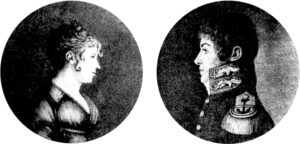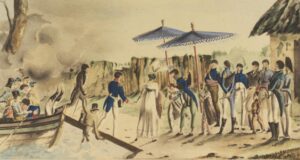When, on the 13th of June 1820, Rose de Freycinet stepped ashore for the second time in Rio de Janeiro, she became just the second women to make a complete circuit of the globe. There was still the voyage back to France ahead of her before her journey would be complete, but she probably considered that almost trivial compared to what she had endured during the previous three years. She would certainly have viewed it with much less trepidation than she had the passage that had first brought her to Rio, a few days before the Christmas of 1817.
Rose was also bringing back to France some items of great value because, unlike her predecessor, Jeanne Baret, who may even have been illiterate, she had kept a diary and written numerous letters. Most of the notebooks in which the diary was written still exist, and are in the safe hands of the Mitchell Library in Sydney, as are copies, probably made during her lifetime, of many of the letters she sent to her mother. The present-day location of those documents tells something else about her story, which is that in her home country Rose is almost forgotten and she is best remembered on the other side of the world, in Australia. In France the diary, which remained hidden in the Freycinet family archives for a hundred years, was eventually published in 1927, but only in a very limited, brutally edited and heavily redacted edition. Despite its many faults and omissions, it was this version that was used as the basis for the diary’s republication in 2003, but by that time the first comprehensive attempt to describe Rose’s life and voyage had been produced by the Australian historian, Marnie Bassett. Her book, ‘Realms and Islands’, which was published in 1952, is long out of print and not very plentifully available on the second-hand market, but now another Australian, Suzanne Falkiner, has recognised the need and has filled it with a handsome volume simply entitled Rose.

Left: Rose Marie Pinon, later de Freycinet, aged 17, two years before her marriage. From an engraving of the original 1812 portrait in the possession of the Freycinet family. Right, Louis de Freycinet. Portrait executed c. 1808, when he would have been 29. On the day of his marriage he was sixteen years older than his wife, a gap that would have been considered quite normal at the time. The portraits appear separately on the relevant Wikipedia pages.
And what a volume it is, and what an extraordinary story Falkiner has to tell. Rose did not simply walk on to her husband’s ship, the three-master corvette Uranie, and sail away. Her presence on it was illegal and she had to be smuggled aboard, on the night before the ship sailed. Nor was it in the Uranie that she returned to France, because that ship was wrecked in the then uninhabited Falkand Islands, where Rose was marooned together with her husband, and also with the full ship’s complement of some 130 officers and men, plus twelve convicts who had stowed away as they left Sydney. It was not until two and a half months later, with the southern winter approaching, that they were all able to leave the islands, in a ship chartered from, and later purchased from, an American who had been running guns to the rebels in Valparaiso. This vessel, originally the Mercury, they renamed La Physicienne.
Rose was not the only person to document the voyage. Her husband wrote the massive official report, which took him the rest of his life to (almost) complete, and the expedition’s artist (an essential crew member on scientific expeditions before photography) published his own highly coloured account almost as soon as the Physicienne had docked in LeHavre. Neither of these dared mention Rose’s presence on board, but they provide alternative views of many of the events she described, as does the unpublished and only recently transcribed account by the ship’s junior surgeon, which occasionally acknowledged her presence (as in Gibraltar, where he noted that the captain went ashore ‘accompanied by his wife, dressed as a man). As far as the circumnavigation was concerned, there was thus almost an embarrassment of material for Falkiner to use, and she has used it skillfully, weaving the different accounts into a seamless whole. This was not, it has to be emphasised, a voyage of exploration but a scientific expedition, and it is that which gives Rose’s narrative its value. One of its objects was to report on the peoples they encountered, and wherever they went they found colonial societies in transition. Brazil was still adjusting to the fact that the Portuguese empire was being ruled from Rio, not Lisbon, and Cape Town and Mauritius were grudgingly accepting that they were now ruled by Great Britain. Further east, the Dutch and Portuguese were at loggerheads in Timor, Guam was ceasing to be an important Pacific way station as Spain lost control of its American colonies, and Hawaii was adjusting to its steadily increasing exposure to the outside world.

Rose de Freycinet coming ashore at Dili, in East Timor. She was smuggled aboard the Uranie wearing men’s clothing, but after that wore them only for a single day in Gibraltar and for the hazardous landings at the lazaretto on Tenerife.
And then of course there was Australia, the uncolonised west of the continent and the newly colonised New South Wales, both of which Louis de Freycinet had visited almost twenty years earlier. The Freycinet name is so well remembered in Australia because not only were Louis and his brother the first to map many of its coasts but he and his wife were among the first outsiders to report on the early days of settlement.
But there is more. As every historian knows, a single document may provide material for a chapter, but the last nuggets of information must be teased from documents that may be hard to find, hard to access and hard to interpret. Falkiner has risen to that challenge, put in the time and the effort, and in doing so has given us not only the voyage of the Uranie, as experienced by its most unexpected participant, but has also detailed Rose’s earlier life and her all too brief life in France after the voyage was over (bizarrely, after all the dangers she had faced on her journey round the world, she died in 1833 in Paris, during an outbreak of cholera). Falkiner’s research has been meticulous, and in one example has solved an outstanding mystery. A famous painting by Alphonse Pellion of the camp in Shark Bay exists in two versions, one of which shows Rose and a small child sitting outside her tent (the other one, for official purposes, shows just the tent). In her journal Rose gave a very guarded explanation of the child’s presence. He was, she said, the son of one of Louis’ friends, who had had to leave him behind on the island even though the mother had died. Louis had volunteered to take the child, who was about seven years old, on board, and had passed him on to Rose to be educated. After Shark Bay, she never mentioned him again, but Falkiner noted that in the complete crew list provided by the draughtsman, Jacques Arago, a ‘mousse’ or cabin boy called Charles is listed as coming on board on Mauritius and remaining with the vssel all the way back to France. Deepening her researches, she eventually found proof, in the form of a letter that she has translated for us, of what many had suspected, which is that this ’friend’ was actually Louis de Freycinet’s brother Charles.
This is a book not only for the scholar but the reader of romance and for anyone in between. Falkiner has done all of us a service by making Rose, her life, her voyage and her all too early death available again, at least in the English-speaking world. Francophones can only hope that some enterprising translator will seize the opportunity and make it available to them too.
